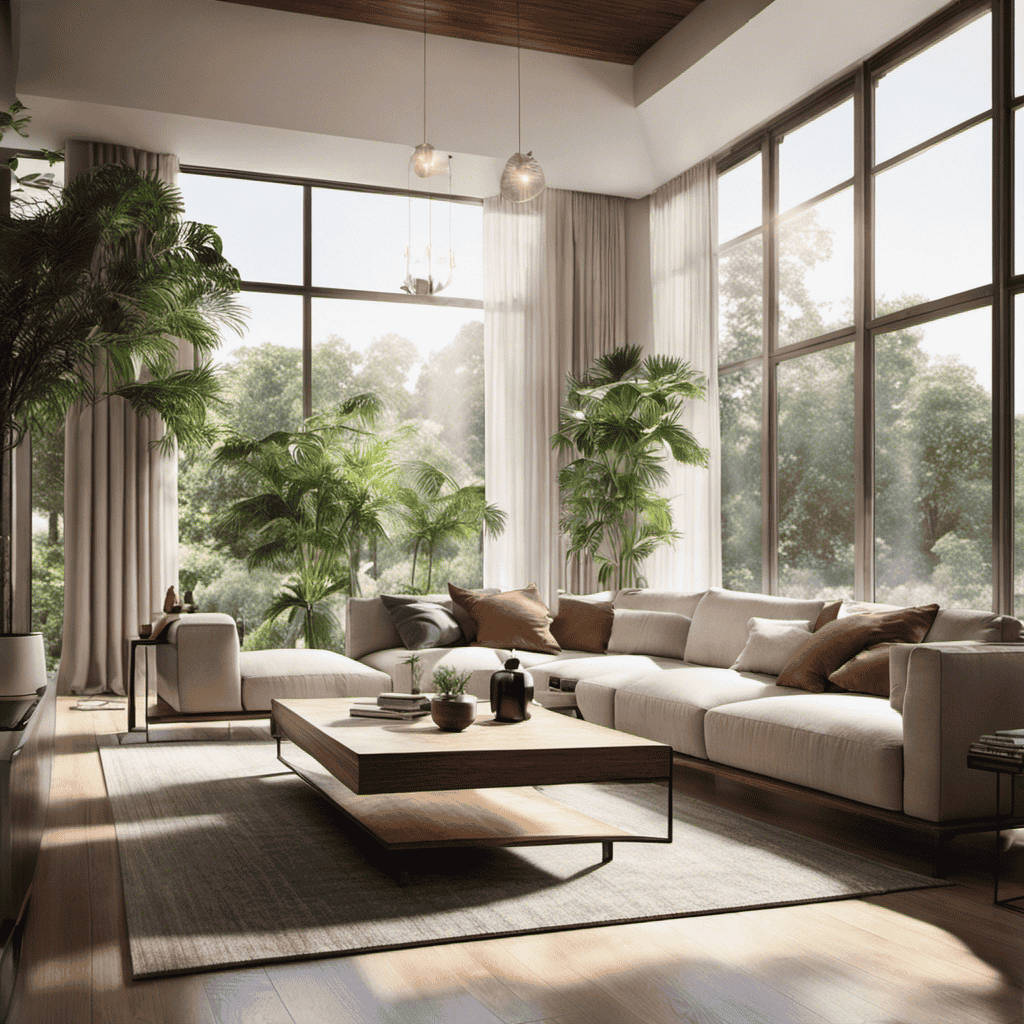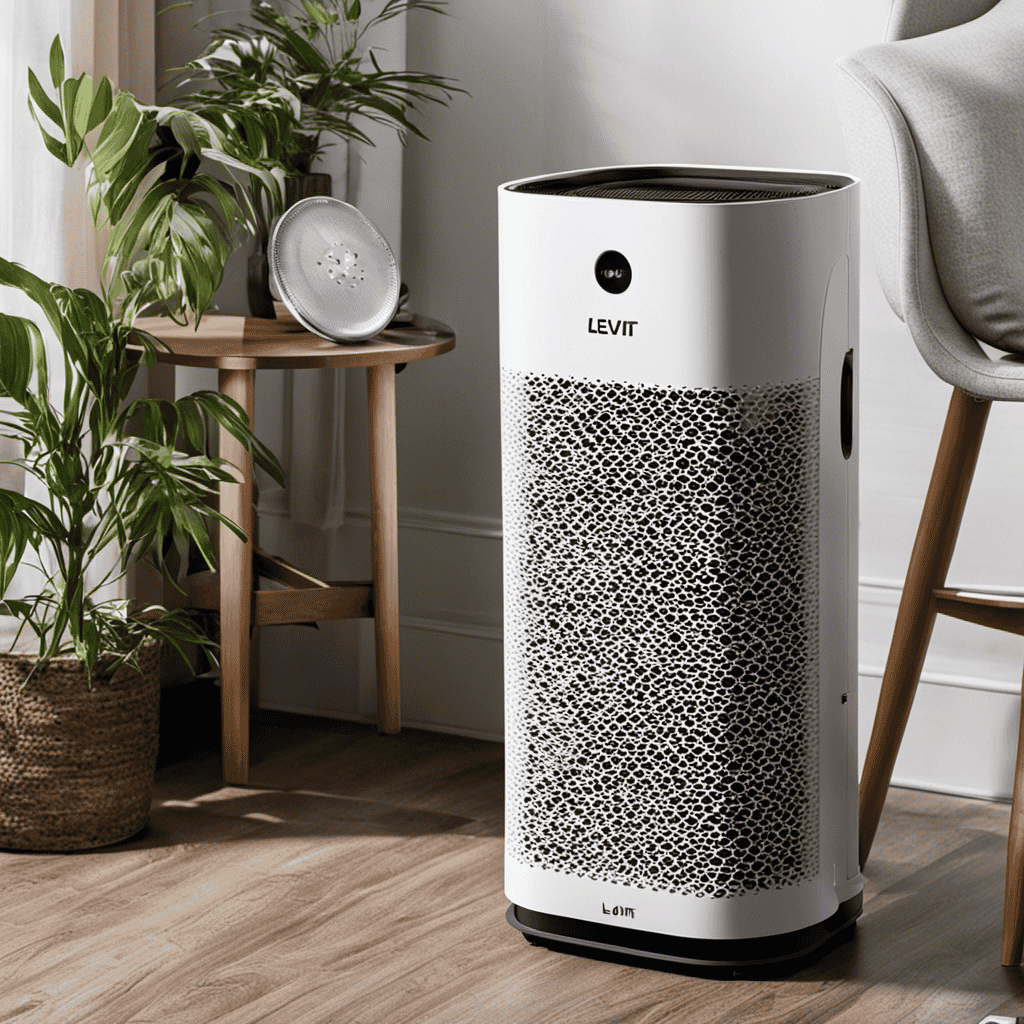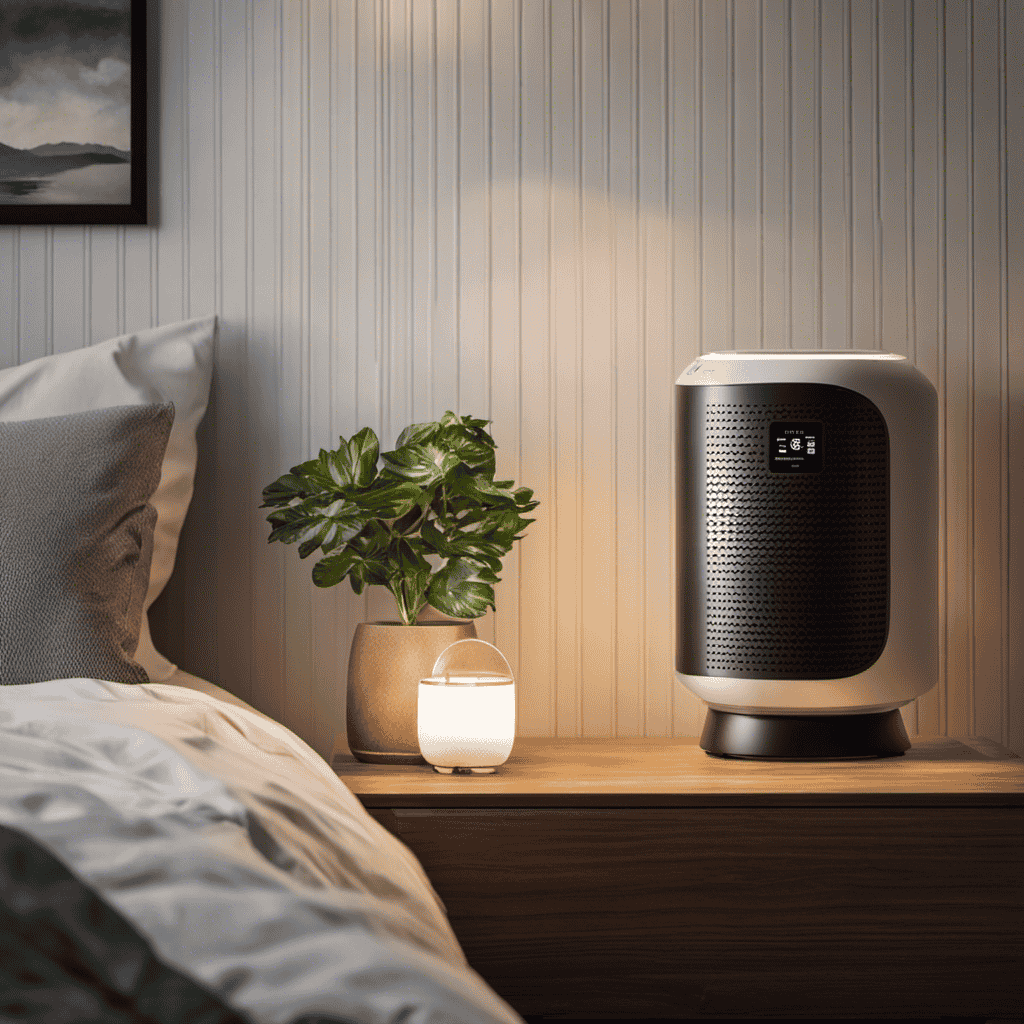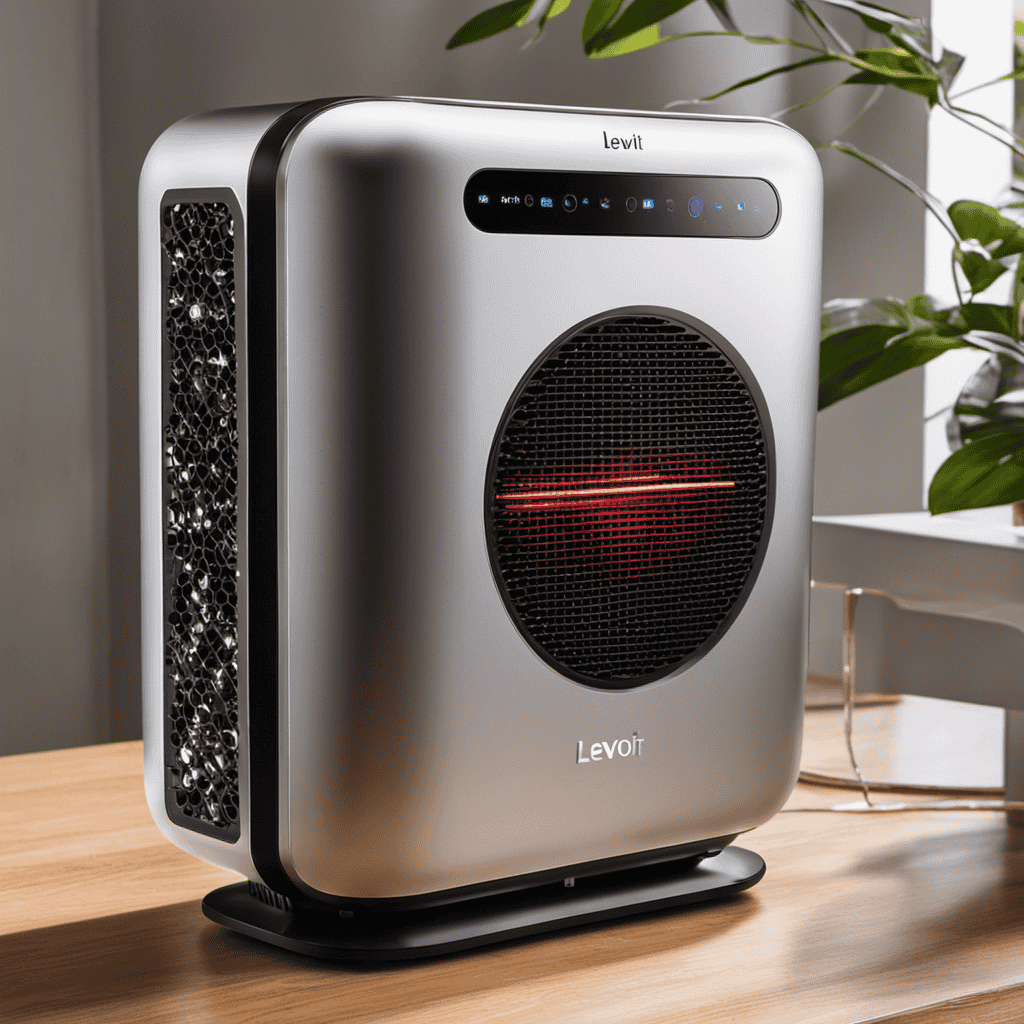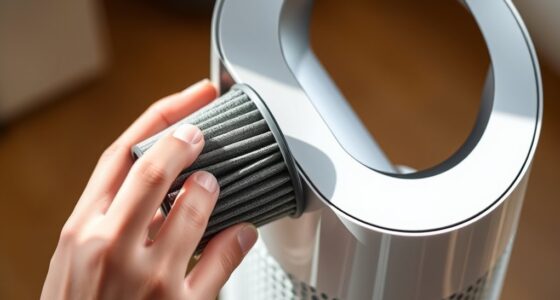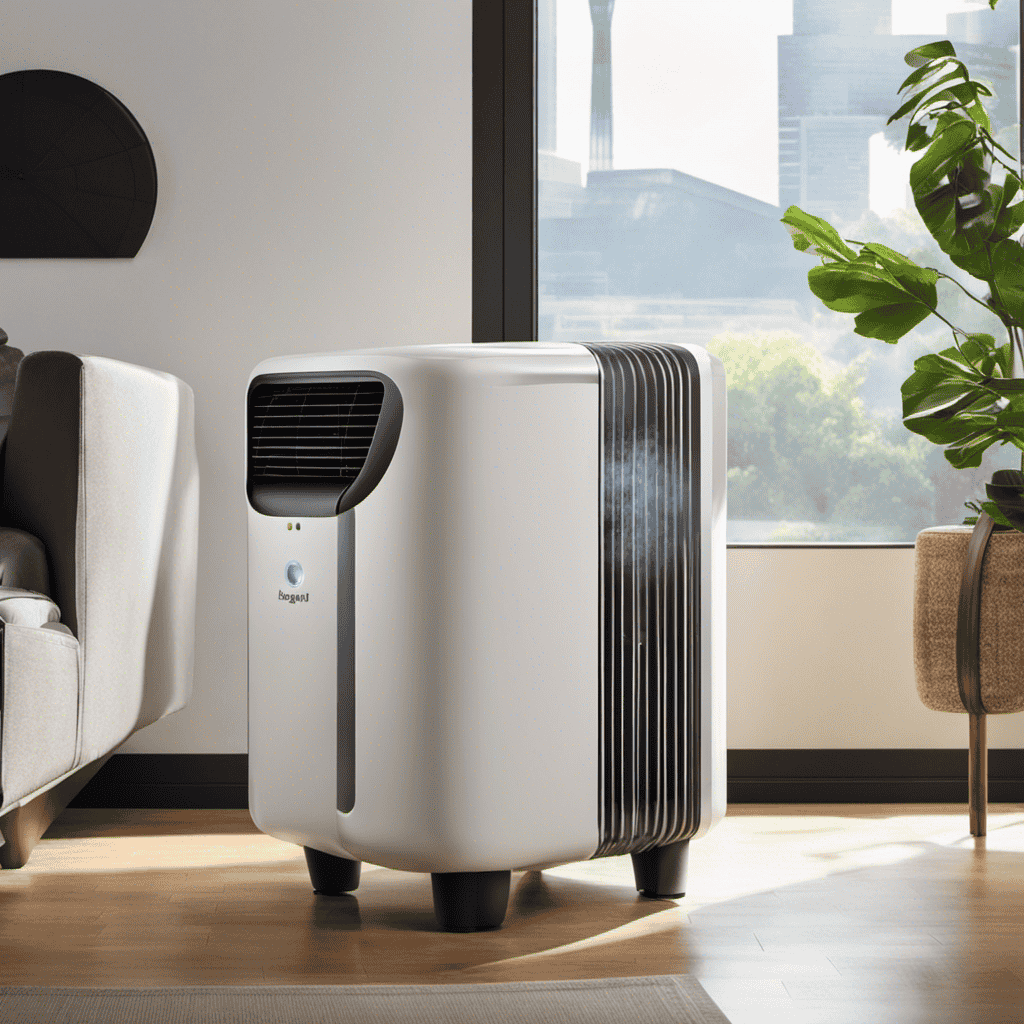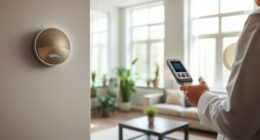I’ve always been curious about how an air purifier can enhance the air quality in my home. I recently stumbled upon an intriguing case study that provided some insights on this matter. It demonstrated how an air purifier successfully eliminated allergens, dust, and other contaminants from the air, resulting in a healthier living space.
Intrigued, I delved deeper into the subject and discovered the various types of air pollutants that can be eliminated by these devices. In this article, I will share my findings and explore the benefits of using an air purifier in your home.
Key Takeaways
- An air purifier removes a variety of pollutants from the air, including dust, pollen, pet dander, mold spores, and volatile organic compounds (VOCs).
- Air purifiers improve indoor air quality by using advanced filtration technology like HEPA filters, activated carbon filters, ultraviolet (UV) light, or ionization technology to remove airborne particles, allergens, and odors.
- Key features to look for in an air purifier include high-quality filtration technology, low noise output, appropriate coverage area, additional features like air quality sensors or programmable timers, and customization options such as Wi-Fi connectivity.
- Using an air purifier in your home provides several benefits, such as reducing allergies and respiratory issues, removing common indoor pollutants, eliminating odors and harmful gases, and creating a fresh and clean-smelling home environment. Regular maintenance is necessary for optimal performance.
Types of Air Pollutants Removed by an Air Purifier
An air purifier can remove various types of air pollutants from your home, such as dust, pollen, pet dander, and mold spores. When it comes to air purifier effectiveness, the type of filter it uses plays a crucial role.
There are different types of air purifier filters available in the market. The most common ones include HEPA filters, activated carbon filters, and ionizers.
HEPA filters are highly effective in removing particles as small as 0.3 microns, capturing up to 99.97% of airborne pollutants.
Activated carbon filters, on the other hand, are excellent at eliminating odors, chemicals, and volatile organic compounds (VOCs).
Ionizers work by releasing negative ions that attach to airborne particles, making them heavy and causing them to fall out of the air.
Understanding the different types of air purifier filters can help you choose the one that best suits your needs.
How an Air Purifier Improves Indoor Air Quality
Using an air purifier can greatly improve the quality of the air inside your house. Air purifiers are designed to remove pollutants and contaminants from the indoor air, creating a healthier living environment. There are several benefits of using an air purifier, including reducing allergies, eliminating odors, and improving respiratory health.
Air purifier technology has advanced significantly in recent years, allowing for more effective filtration and purification. Many air purifiers use High Efficiency Particulate Air (HEPA) filters, which can capture particles as small as 0.3 microns, including pollen, dust mites, pet dander, and mold spores. Some air purifiers also incorporate activated carbon filters to remove odors and volatile organic compounds (VOCs) from the air. Additionally, certain air purifiers use ultraviolet (UV) light or ionization technology to kill bacteria and viruses, further improving indoor air quality.
Overall, using an air purifier can provide numerous benefits for your home, promoting cleaner and healthier air for you and your family to breathe.
Table:
| Air Purifier Benefits | Air Purifier Technology |
|---|---|
| Reduces allergies | HEPA filters |
| Eliminates odors | Activated carbon filters |
| Improves respiratory health | UV light/ionization technology |
Key Features to Look for in an Air Purifier
When shopping for an air purifier, you should consider the key features that will best meet your needs and improve the quality of indoor air. Here are four important features to look for:
-
Air Purifier Technology: Look for purifiers that use high-quality filtration technology, such as HEPA filters or activated carbon filters. These can effectively remove airborne particles, allergens, and odors from the air.
-
Noise Levels: Consider the noise levels of the air purifier, especially if you plan to use it in a bedroom or office space. Look for models that have a low noise output, so they won’t disturb your sleep or work environment.
-
Coverage Area: Determine the size of the room or area where you plan to use the air purifier. Make sure to choose a purifier that has the appropriate coverage area to effectively clean the air in that space.
-
Additional Features: Some air purifiers come with additional features, such as air quality sensors, programmable timers, or Wi-Fi connectivity. These can provide added convenience and customization options for your specific needs.
Benefits of Using an Air Purifier in Your Home
The benefits of having an air purifier in your home are numerous and can greatly improve the quality of indoor air. Research has shown that air purifiers are effective at removing common indoor pollutants such as dust, pollen, pet dander, and mold spores.
By filtering out these airborne particles, air purifiers can help reduce allergies and respiratory issues. Additionally, air purifiers can also remove odors and harmful gases from the air, making your home smell fresh and clean.
To maintain the effectiveness of your air purifier, regular maintenance is necessary. This includes cleaning or replacing the filters as recommended by the manufacturer. Some air purifiers also require periodic maintenance of the internal components to ensure optimal performance.
Understanding the Filtration Process in an Air Purifier
To better understand how an air purifier filters out pollutants, you can think of it as a device that captures and traps harmful particles in the air you breathe.
Here’s a breakdown of the filtration process in an air purifier:
-
Pre-Filter: This initial filter captures larger particles like dust and pet dander, extending the lifespan of the main filter.
-
HEPA Filter: High-Efficiency Particulate Air (HEPA) filters are the most common type used in air purifiers. They effectively remove 99.97% of particles as small as 0.3 microns, including pollen, mold spores, and bacteria.
-
Activated Carbon Filter: This filter helps eliminate odors, gases, and volatile organic compounds (VOCs), by adsorbing them onto a porous carbon surface.
-
UV-C Light: Some air purifiers use ultraviolet (UV) light to kill bacteria and viruses, preventing them from being recirculated into the air.
Understanding the air filter technology and the various air purification methods helps you make an informed decision when choosing an air purifier for your home.
Common Misconceptions About Air Purifiers
When it comes to air purifiers, there are a few key points that often come up for discussion.
One of the main benefits of using an air purifier is the improvement in air quality it provides.
Additionally, the allergen elimination process is another important aspect to consider.
Finally, energy consumption concerns are also a topic worth exploring, as it can affect the overall effectiveness and cost of operating an air purifier.
Overall, understanding these three key points can help us make informed decisions when it comes to choosing and using an air purifier.
Air Quality Improvement
Using an air purifier can greatly improve the quality of air in your home. Air purifiers are designed to remove various pollutants and allergens from the air, making it cleaner and healthier to breathe. Here are four reasons why air purifiers are effective in improving air quality:
-
Filtration: Air purifiers use filters to trap particles such as dust, pollen, pet dander, and mold spores. This helps reduce the presence of these allergens in the air.
-
Odor elimination: Some air purifiers are equipped with activated carbon filters that can remove unpleasant odors, such as cooking smells or pet odors.
-
Air circulation: Air purifiers help to circulate and filter the air in a room, ensuring that the entire space benefits from cleaner air.
-
Reduced respiratory issues: By removing airborne irritants, air purifiers can help alleviate symptoms of respiratory conditions like asthma, allergies, and sinus problems.
To maintain the effectiveness of your air purifier, regular maintenance is necessary. This includes cleaning or replacing filters, cleaning the unit, and following the manufacturer’s guidelines for optimal performance.
Allergen Elimination Process
By regularly cleaning and replacing the filters in your air purifier, you can effectively eliminate allergens from the air in your home. Dust mites and pet dander are common allergens that can trigger respiratory issues and allergies.
Air purifiers work by pulling in the surrounding air and passing it through a series of filters. These filters are designed to capture and trap particles such as dust mites and pet dander. The HEPA (High-Efficiency Particulate Air) filters used in air purifiers have a fine mesh that can efficiently capture even the smallest particles.
By regularly cleaning and replacing these filters, you ensure that your air purifier continues to effectively eliminate allergens, providing cleaner and healthier air for you and your family.
Now, let’s discuss the energy consumption concerns associated with air purifiers.
Energy Consumption Concerns
Air purifiers consume electricity, so it’s essential to consider their energy consumption when using them in your home. Here are some factors to consider regarding energy efficiency and noise levels when choosing an air purifier:
-
Energy Efficiency: Look for air purifiers with an Energy Star certification. These models are designed to use less energy without compromising performance. They can save you money on your electricity bill in the long run.
-
Noise Levels: Consider the noise level of the air purifier, especially if you plan to use it in your bedroom or living room. Look for models with adjustable fan speeds, as lower settings tend to be quieter. Some air purifiers also have a ‘sleep mode’ that operates at a whisper-quiet sound level.
-
Timer Function: Opt for an air purifier with a timer function. This allows you to set the purifier to run for a specific duration, helping to conserve energy and reduce noise when you don’t need it.
-
Power Consumption: Check the power consumption specifications of the air purifier. Look for models that consume less energy while still providing effective air cleaning. Lower power consumption means less impact on the environment and lower energy costs for you.
Considering energy efficiency and noise levels when selecting an air purifier will help you make an informed decision that meets your needs while minimizing environmental and financial impact.
Choosing the Right Size Air Purifier for Your Home
When it comes to choosing the right size air purifier for your home, there are a few key factors to consider.
First, you’ll want to determine the ideal room size for the air purifier to effectively clean the air.
Second, understanding the airflow capabilities of the air purifier is crucial to ensure proper circulation.
Lastly, considering the coverage area of the air purifier will help determine if it can effectively clean the air in multiple rooms or just a specific area.
Ideal Room Size
To determine the ideal room size for an air purifier, you’ll need to consider the square footage of the space. The size of the room plays a crucial role in the efficiency of the air purifier. Here are some key points to keep in mind:
-
Measure the square footage: Start by measuring the length and width of the room. Multiply these values to get the square footage.
-
Match the purifier’s coverage area: Check the specifications of the air purifier to see its recommended coverage area. Choose a purifier that can effectively clean the square footage of your room.
-
Consider the ceiling height: If you have high ceilings, you may need a more powerful purifier to effectively clean the air in the entire room.
-
Multiple units for larger rooms: If your room is larger than the coverage area of a single purifier, consider using multiple units strategically placed to ensure comprehensive air purification.
Airflow and Coverage
If you want optimal results, make sure the air purifier you choose has sufficient coverage for your room size. Airflow and coverage are crucial factors in air purifier performance and efficiency.
When an air purifier has proper airflow, it can effectively circulate and filter the air in your room. This ensures that pollutants, allergens, and other airborne particles are continuously captured and removed.
The coverage of an air purifier refers to the maximum area it can effectively clean. It is important to consider the square footage of your room when selecting an air purifier to ensure it can efficiently clean the air in that space.
Choosing an air purifier with the right airflow and coverage will enhance its performance and efficiency, resulting in cleaner and healthier indoor air.
Maintenance Tips for Your Air Purifier
Regularly clean the filters in your air purifier to ensure its optimal performance. Here are some cleaning tips to keep your air purifier running smoothly:
-
Check the manufacturer’s instructions: Different air purifiers may have specific cleaning requirements. Make sure to read the manual to understand how to properly clean your purifier.
-
Vacuum the exterior: Dust and dirt can accumulate on the outside of your air purifier. Use a soft brush attachment on your vacuum cleaner to gently remove any debris.
-
Clean or replace filters: Depending on the type of air purifier you have, you may need to clean or replace the filters. Washable filters should be cleaned regularly, while disposable filters should be replaced according to the manufacturer’s recommendations.
-
Clean the air intake vents: Dust and particles can build up on the intake vents, hindering the airflow. Use a soft brush or cloth to remove any obstructions.
How an Air Purifier Can Help With Allergies and Asthma
When it comes to finding relief from allergies and reducing asthma symptoms, an air purifier can be a game-changer.
The allergy relief benefits of using an air purifier are well-documented and backed by research.
In addition, studies have shown that air purifiers can significantly decrease asthma symptoms by removing triggers like dust, pollen, and pet dander from the air.
Allergy Relief Benefits
You’ll notice a significant reduction in allergy symptoms with an air purifier in your home. Here are the allergy relief benefits that an air purifier can provide:
-
Allergen Removal: Air purifiers are designed to capture and remove common allergens such as pollen, dust mites, pet dander, and mold spores from the air. This helps prevent these allergens from triggering any respiratory reactions.
-
Cleaner Air: By removing allergens and other airborne particles, air purifiers help improve the overall air quality in your home. This can lead to a healthier living environment and reduce the risk of respiratory issues.
-
Asthma Management: For individuals with asthma, air purifiers can be particularly beneficial. They help eliminate asthma triggers like dust and pet dander, which can help prevent asthma attacks and improve respiratory health.
-
Sleep Quality: Allergies can often disrupt sleep due to symptoms like sneezing, congestion, and itching. By reducing allergens in the air, air purifiers can help create a more comfortable sleep environment, leading to better rest and overall well-being.
Investing in an air purifier can significantly contribute to allergy prevention and improvement in respiratory health.
Asthma Symptom Reduction
Asthma symptoms can be reduced with the use of an air purifier.
As someone who has struggled with asthma for years, I can attest to the benefits of having an air purifier in my home.
Research shows that air purifiers can help remove asthma triggers such as dust mites, pet dander, pollen, and mold spores from the air. By filtering out these allergens, air purifiers create a cleaner and healthier indoor environment, reducing the likelihood of asthma attacks.
Additionally, air purifiers can help improve air quality by removing harmful pollutants like smoke, chemicals, and volatile organic compounds (VOCs). This further enhances asthma management and overall respiratory health.
Investing in an air purifier is a proactive step towards creating a safe haven for individuals with asthma.
Factors to Consider When Purchasing an Air Purifier
Before making a purchase, it’s important to consider factors like the size of the room and the specific pollutants you want the air purifier to target. Here are four key factors to consider when purchasing an air purifier:
-
Room size: The size of the room will determine the appropriate size and power of the air purifier. Consider the square footage and choose a purifier that can effectively clean the air in that space.
-
Filter type: Different air purifiers use different types of filters to remove pollutants from the air. HEPA filters are highly effective at capturing small particles like dust, pollen, and pet dander, while activated carbon filters can remove odors and chemicals.
-
Noise level: Some air purifiers can be noisy, especially on higher fan speeds. If you plan to use the purifier in a bedroom or office, consider the noise level and look for models with quieter operation.
-
Cost comparison: Air purifiers can vary widely in price. Consider your budget and compare the cost of different models, taking into account factors like filter replacement costs and energy efficiency.
– Can an Air Purifier Help with Humidity Control in a Home?
An air purifier can help with humidity control in a home by capturing excess moisture in the air, but its main function is to remove airborne particles, not necessarily to lower humidity levels. For effective humidity control, a dehumidifier is more suited for the job. Understanding the dehumidifier vs air purifier comparison is essential for choosing the right solution.
Frequently Asked Questions
Can an Air Purifier Remove Viruses and Bacteria From the Air?
Yes, an air purifier can remove viruses and bacteria from the air. Its effectiveness lies in its ability to capture and trap these harmful particles, providing numerous benefits for cleaner and healthier indoor air.
Can an Air Purifier Eliminate Cooking Odors?
Yes, an air purifier can eliminate cooking odors and reduce indoor pollution. It filters out the particles and chemicals in the air, leaving your home smelling fresh and clean.
Is It Safe to Run an Air Purifier All Day and Night?
Running an air purifier all day and night has its pros and cons. While it continuously cleans the air, it can also increase electricity usage and noise levels. However, the benefits of using it in bedrooms include improved air quality and potential relief from allergies.
Do Air Purifiers Produce Ozone?
Air purifiers can produce ozone, which can be harmful in high concentrations. It’s important to choose an air purifier that meets safety standards and doesn’t produce excessive ozone levels to ensure indoor air quality.
Can an Air Purifier Help With Pet Allergies?
An air purifier can definitely help with pet allergies. I remember a friend who had severe allergies to cats but could finally breathe freely after using an air purifier. It’s amazing how effective they can be. Some of the best air purifier brands include Honeywell and Dyson.
Conclusion
In conclusion, an air purifier is an essential device for improving the air quality in your home. It effectively removes various types of air pollutants, such as dust, pollen, pet dander, and even harmful chemicals.
With key features like HEPA filters and activated carbon filters, air purifiers can significantly reduce allergens and pollutants in the air. Not only does it help with allergies and asthma, but it also benefits overall health and well-being.
So, if you want to breathe cleaner and fresher air, investing in an air purifier is a must. It’s like having a magical device that transforms your home into a pristine sanctuary.
